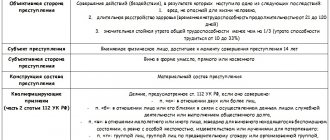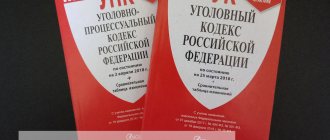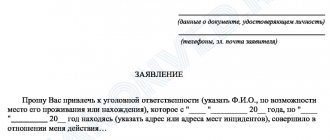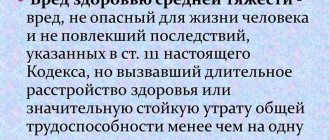Concept and legislative framework
Article 115 of the Criminal Code of the Russian Federation provides for criminal liability for intentional infliction of minor harm to health.
In Art. 115 of the Criminal Code of the Russian Federation defines the concept of “minor harm to health” and provides a reference to the Decree of the Government of the Russian Federation of August 17, 2007 No. 522, which approved the Rules for determining the severity of harm caused to human health. For a more complete understanding of the features of this crime, we will present in a condensed form a few comments from a lawyer to Art. 115:
- the subjective side of the crime presupposes the presence of intent, the criminal is aware of the danger of causing minor harm to health, foresees the possibility (inevitability) of consequences as a result of his actions and desires their occurrence;
- punishment depends on the circumstances and motives of the crime;
- unintentional (careless) infliction of minor harm to health is qualified, depending on the circumstances, as an administrative offense in accordance with the provisions of the Code of Administrative Offenses of the Russian Federation or as a situation subject to resolution through civil proceedings or agreement of the parties.
The Supreme Court explained without which signs one cannot be convicted of threatening to kill
July 29, 2021
A mutual conflict that has escalated into a fight can hardly be interpreted as a threat to kill, even if one of the fighters was scared, since his opponent is physically stronger, explains the Supreme Court of the Russian Federation.
A mandatory sign of a murder threat is its reality, and assessing the reality of the threat is a subjective and objective criterion, he reminds.
The crux of the matter
The highest authority examined the case of a resident of the Kurgan region, sentenced to 360 hours of compulsory labor for threatening to kill. According to the materials, the defendant and the victim beat each other during a mutual conflict, and both participants in the fight received injuries.
In the complaint, the lawyer indicated that the description of the objective side of the act consists of beatings and constitutes an administrative offense; his client did not express verbal threats of murder or causing grievous harm to the victim’s health, or other threatening actions that would give the victim reason to consider the threat real and fear its implementation, also didn't do it.
Position of the Armed Forces
Article 119 of the Criminal Code of the Russian Federation provides for criminal liability for threats to kill or cause grievous bodily harm if there were grounds to fear that this threat would be carried out, reminds the Supreme Court.
“The subjective side of this crime is characterized by guilt in the form of direct intent. The perpetrator is aware of the social danger of his actions and wishes to express his intention to take the life or cause serious harm to the health of a specific person.”
, explains the highest authority.
From the verdict it is clear that the threat to kill was expressed in the fact that the defendant, during the conflict, with the intent to create a real threat to the life and health of the victim, deliberately struck him with his hands, a metal object and his feet. The victim perceived these actions as a real threat to his life and health and he had real reasons to fear its implementation, because the accused was aggressive and physically stronger.
However, at the court hearing, the convict explained that he had a conflict with the victim, which escalated into a mutual fight, during which they both struck each other, while he did not express any threats.
To substantiate the conclusion of guilt, the court referred in the verdict, including the expert’s opinion, on the presence of bodily injuries on the victims’ faces, which were caused by the action of a blunt object (objects) and did not cause harm to the victim’s health.
At the same time, the court ignored the expert’s conclusion about the presence of bodily injuries on the convict in the form of two bruises in the face, hemorrhage in the mucous membrane of the upper lip, bruising and post-traumatic swelling of the soft tissues of the first finger of the right hand, which do not cause harm to human health, the Supreme Court points out. .
Motivating the conclusion of guilt, the court indicated that a threat to kill can be expressed in any form and the absence of verbal threats does not exclude criminal liability under this article.
«Meanwhile, within the meaning of the criminal law, a threat to kill is a type of mental violence and can be expressed in any form, verbally, in writing, by gestures, by demonstration of weapons, etc. The content of a death threat is a statement of intent to take life; the threat is designed to intimidate the victim. An essential feature of such a threat is its reality.
Assessing the reality of a threat is a subjective and objective criterion. The subjective criterion is characterized by the intention of the perpetrator to carry out the threat and the victim’s perception of this threat as life-threatening. In this case, the threat must be obvious to the victim.
An objective criterion for assessing the reality of a threat is established taking into account the circumstances characterizing the situation in which the victim is threatened, the identity of the threat, the relationship between the victim and the perpetrator,”
— explains the Armed Forces.
Meanwhile, according to the circumstances established by the court, a conflict arose between the convicted and the victim on the basis of personal hostility.
At the same time, the court did not provide the motives on the basis of which it came to the conclusion that the convicted person had direct intent to commit a threat to kill, as well as the reality of the perception of such a threat by the victim.
Having examined the issue of the victim’s subjective perception of the reality of the threat of murder, the court did not properly examine and take into account all the factual circumstances of the case, the behavior of the convicted person and the victim, the personality of the accused, the nature of the relationship between the victim and the convicted person, the circumstances of the mutual conflict that occurred between them, the Supreme Court believes.
Therefore, he overturned the conviction and sent the case for a new trial to the court of first instance.
All news
Source:
RAPSI
Criteria for minor health damage
According to Part 1 of Art. 115 of the Criminal Code of the Russian Federation and clause 4c of the Rules approved by Resolution 522, minor harm to health is a short-term health disorder or a minor permanent loss of general ability to work. More precisely, the medical criteria for establishing minor harm to health are indicated in the Appendix to the Order of the Ministry of Health and Social Development dated April 24, 2008 No. 194n. According to clause 8 of the Appendix, minor bodily injuries include injuries that lead to:
- short-term health disorder, that is, temporary disruption of the functions of organs and/or systems lasting from the moment of injury to the 21st day (inclusive);
- permanent loss of general ability to work is less than 10%.
The severity of harm caused to human health is determined by a forensic medical expert of a medical institution or individual entrepreneur who has special knowledge and is licensed to carry out medical activities, including work (services) on forensic medical examination (clause 6 of the Rules).
Mild Injury Law
Harm to health can be caused intentionally or unintentionally.
- In the first case, liability will be regulated by Article 115 of the Criminal Code of the Russian Federation.
- In the second case, it will not be regulated by the Criminal Code, since the person caused harm through negligence, and therefore this is not a crime, since it does not have the elements of a crime.
Corpus delicti
The corpus delicti under Art. 115 of the Criminal Code of the Russian Federation arises if the following circumstances simultaneously occur:
- conscious (intentional) causing harm to health;
- harm to health of mild severity (minor injury), falling under the medical criteria of clause 8 of the Appendix to Order of the Ministry of Health 194n.
Intentional infliction of minor bodily harm should be distinguished from battery. According to Part 1 of Art. 116 of the Criminal Code of the Russian Federation, beatings are violent actions that do not entail the consequences specified in Art. 115. These include, in particular, abrasions, bruises, soft tissue bruises and other injuries that do not lead to short-term health problems or minor permanent loss of general ability to work (clause 9 of the Appendix to Order of the Ministry of Health 194n).
It is also necessary to distinguish between an intentional act and causing minor harm to health through negligence. As stated earlier, unintentionally causing minor bodily harm is not a criminal offense.
Punishment for causing minor bodily harm
Liability for causing minor bodily injury, provided for in Art. 115 of the Criminal Code of the Russian Federation:
- for an “ordinary” crime without aggravating circumstances, a fine of up to 40 thousand rubles or in the amount of income for a period of up to 3 months, or compulsory labor for up to 480 hours, or correctional labor for up to 1 year, or arrest for up to 4 months (Part 1);
- in aggravating circumstances, compulsory labor for up to 360 hours, or correctional labor for up to 1 year, or restriction of freedom for up to 2 years, or forced labor for up to 2 years, or arrest for up to 6 months, or imprisonment for up to 2 years (part 2).
According to the provisions of Part 2 of Art. 115 aggravating circumstances include causing harm to health of mild severity:
- for hooligan reasons;
- based on political, ideological, racial, national or religious hatred (hostility);
- with the use of weapons (objects used as weapons);
- in relation to a person (his relatives) in connection with his official activities, the performance of public duty.
Causing minor harm to the health of a minor is not included in the list of aggravating circumstances, but may be taken into account by the court when passing a sentence.
What will determine the severity of the sentence?
The punishment depends on the category of damage and the presence of qualifying features.
Categories of minor bodily injury:
- minimal injuries that did not entail loss of ability to work and deterioration of health for a certain period, namely, what heals within 6 days: dislocation, minor bruise, scratch, etc.
- More serious damage, leading to more serious consequences, namely that it heals from 6 days to three weeks, 10% loss of ability to work, etc.
Qualifying features
- A crime that caused more than 2 people to be injured.
- Assault while performing official duties.
- If the victim was a minor and could not defend herself.
- A crime that was committed by force and humiliation.
- A criminal group consisting of several people.
- A crime committed due to ordinary hooliganism.
- The villain who used the weapon.
- Discrimination against religion or race.
How does the punishment change depending on them?
- Penalties are applicable only if there are no qualifying criteria.
- If there are no qualifying features, arrest is possible for up to 4 months, if there are – up to six months.
- Correctional work can last a maximum of a year in both cases.
- Without qualifying signs you will not be imprisoned, but with them you can be imprisoned for up to two years or limited for up to two years, there is also such a punishment as forced labor for up to two years.
- In the absence of qualifying characteristics, they may be required to perform community service for up to 480 hours, with their presence up to 360 hours of community service.
For clarity, let's look at several examples with and without qualifying features.
Case 1
Kremleva K.L. deliberately began to provoke the girl into a fight. After the attempt failed, she simply started punching her. In this case, the victim simply defended herself and did not fight back. She ended up with a contusion, bruises all over her body and several scratches.
The reason for the attack was hooliganism, the victim was a minor, could not defend herself, the provocation was due to racial discrimination. In addition, Kremleva has a criminal record. Due to a fairly impressive list of aggravating features, she may receive, for example, a prison sentence of up to two years or a suspended sentence.
Case 2
A group of unknown people approached D.M. Makarov and, after an unsuccessful attempt to take away valuables, started a fight. Makarov tried to defend himself, but he did not strike back. Some time later, after they unsuccessfully tried to take the phone and money, one of the accomplices took out a knife, which he accidentally hit the victim, resulting in a small wound.
After a medical examination, the body was found to have bruises, a dislocated right leg, scratches and a knife wound. The aggravating features include the following: attack by a criminal group, hooliganism, use of knives. This case also has a high probability that those who committed such a crime will go to jail.
Case 3
Vershinin D.L. stood up for the girl and started a fight with another guy. The guy did not fight back, he only defended himself. Vershinin was punched several times, resulting in bruises and one contusion on the body.
There are no aggravating features here: no weapon was used, there was only one attacker, the victim was an adult, the cause of the fight was not hooliganism. Therefore, here, most likely, there will be penalties of up to 40 thousand rubles or up to three monthly salaries.
How to hold a person accountable
To prosecute an offender for causing minor bodily harm, you need to:
- Contact a medical facility, undergo an examination for injuries, record them, and undergo treatment.
- Obtain an expert's opinion on causing minor harm to health.
- Write a statement to the police about the incident, indicate in it the details of witnesses (if they were present at the incident), and attach an expert opinion.
It is not a fact that the police will open a criminal case based on the victim’s statement; there is a possibility that this will be denied to the applicant. In this case, an application to initiate a criminal case should be filed with the Magistrates' Court as a private prosecution. In this case, the applicant will be given explanations about the possibility of reconciliation with the offender.
Bringing to justice for causing minor harm to health is not an easy matter, requiring knowledge of many legal nuances. To achieve results, we recommend that you seek advice from a lawyer on our website. He will give detailed explanations of the situation and help the victim protect his legal rights.
Arbitrage practice
In 2021, according to Art. 115 of the Criminal Code of the Russian Federation, about 11 thousand people were convicted in Russia, and in approximately 85% of cases under Part 2, that is, in the presence of aggravating circumstances. In almost 30% of cases, the courts sentenced the accused to compulsory labor, in 20% - suspended imprisonment, and in 15% - actual imprisonment. Cases in this category are characterized by a lot of nuances that are taken into account when sentencing. Let us give an example of causing minor harm to health and the punishment that was awarded to the offender.
Citizen M. was near the bar, where he had a plan to harm the health of citizen D., previously unknown to him, who made a remark to M. because of the latter’s obscene language. M., using an insignificant reason, out of hooligan motives, started a conflict with D., during which he used a picked up stick as an object used as a weapon and deliberately struck the victim twice on the head. As a result of this, D. experienced physical pain, received an injury in the form of a concussion and a bruised wound on the scalp. The victim was hospitalized in a medical facility for 12 days; according to the conclusion of a medical expert, the injury was assessed as minor harm to health due to his short-term disorder. Based on the totality of the facts, the court found M. guilty of committing a crime under paragraphs. a) and c) Art. 115 of the Criminal Code of the Russian Federation (intentional infliction of minor harm to health from hooligan motives and with the use of weapons) and sentenced him to 10 months in prison.






